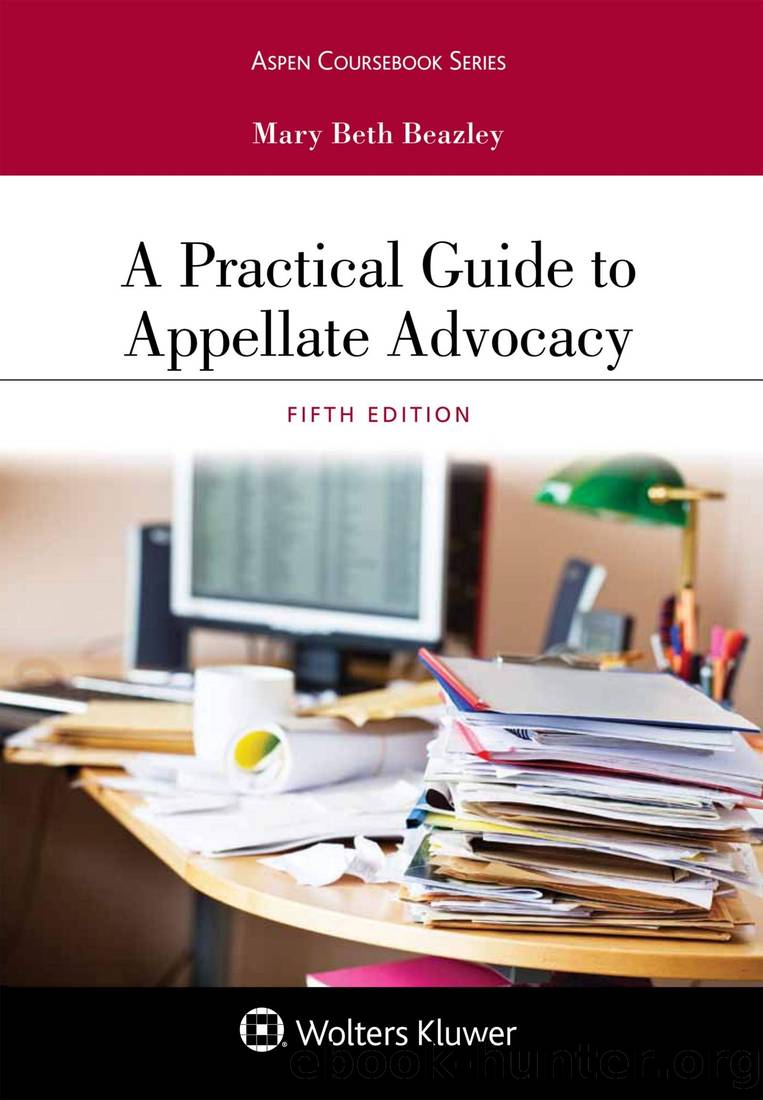A Practical Guide to Appellate Advocacy by Mary Beth Beazley

Author:Mary Beth Beazley
Language: eng
Format: mobi
Tags: Law, Legal Education, Legal Writing
ISBN: 9781454896340
Publisher: Wolters Kluwer Law & Business
Published: 2018-09-13T21:00:00+00:00
7.7
SUMMARY
This chapter provides a brief glance at the many possibilities for statutory interpretation arguments. The most important thing you can do to make these arguments effectively is to read and understand the statute at issue. That knowledge will allow you to find available arguments, and to recognize both intrinsic and extrinsic authorities that can advance your clientâs case.
Chapter Seven Review
1. With a new fact pattern, be sure to do statutory research.
2. Start with plain language.
3. Read the rest of the statute, the rest of the chapter, and the rest of the title (or at least its table of contents).
4. The more straightforward your analysis is, the more likely the court will be to agree with it.
5. Courts like consistency: Itâs good to argue that a word should mean the same thing throughout a statute, and that a phrase should mean the same thing in two similar statutes.
6. Use legislative history as further support, not sole support.
7. Both changed language and lack of changed language can be significant.
8. Donât reinvent the wheel: Use your statute number as a search term, and look for cases and law review articles that have analyzed its language and legislative history.
9. Be able to translate Latin phrases, and to research canon arguments using language other than the formal name of the canon.
10. Remember the lessons of the abstraction ladder: Unless you are making an in pari materia argument, you donât need to look for cases in which courts were interpreting identical statutes. Pay attention to the legally significant categories. What statutory problem was that court solving?
1 E.g., William Eskridge Jr. et al., Cases and Materials on Legislation and Regulation: Statutes and the Creation of Public Policy (5th ed. West 2014); Antonin Scalia & Bryan A. Garner, Reading Law: The Interpretation of Legal Texts (2012).
2 Frank H. Easterbrook, The Absence of Method in Statutory Interpretation, 84 U. Chi. L. Rev. 81, 83 (2017) (âI am skeptical of canons, and not simply because of Professor Karl Llewellynâs famous list of canons and countercanonsâ) (citing Karl N. Llewellyn, Remarks on the Theory of Appellate Decision and the Rules or Canons About How Statutes Are to Be Construed, 3 Vand. L. Rev. 395, 401-06 (1950).
3 Easterbrook, supra note X, at 83.
4Anita S. Krishnakumar, Dueling Canons, 65 Duke L.J. 909, 1006 (2016).
5James J. Brudney & Corey Ditslear, Canons of Construction and the Elusive Quest for Neutral Reasoning, 58 Vand. L. Rev. 1, 4 (2005)
6See Easterbrook, supra note X, at 82.
7E.g., Pereira v. Sessions, No. 17-459, 2018 WL 3058276, at *8 (U.S. June 21, 2018) (noting that âit is a normal rule of statutory construction that identical words used in different parts of the same act are intended to have the same
meaningâ) (citation and internal quotation marks omitted); Food & Water Watch, Inc. v. United States Envtl. Prot. Agency, 302 F. Supp. 3d 1058 (N.D. Cal. 2018) (noting the âgeneral principle of statutory construction that when Congress includes particular language in one section of a statute but omits it in another section
Download
This site does not store any files on its server. We only index and link to content provided by other sites. Please contact the content providers to delete copyright contents if any and email us, we'll remove relevant links or contents immediately.
Killers of the Flower Moon by David Grann(3228)
Machine Learning at Scale with H2O by Gregory Keys | David Whiting(2269)
Will by Will Smith(2033)
Guns, Germs and Steel by Diamond Jared(1876)
Borders by unknow(1780)
The Room Where It Happened by John Bolton;(1717)
The Color of Law by Richard Rothstein(1574)
Once Upon a Broken Heart by Stephanie Garber(1472)
Water Rights and the Environment in the United States by John Burch(1414)
Examples & Explanations: Administrative Law by William F. Funk & Richard H. Seamon(1324)
Friends, Lovers, and the Big Terrible Thing by Matthew Perry(1324)
A Short History of War by Jeremy Black(1295)
Pharmacy Practice and The Law by Richard Abood(1252)
HBR's 10 Must Reads 2022 by Harvard Business Review(1251)
That Every Man Be Armed by Stephen P. Halbrook(1236)
The Strength In Our Scars by Bianca Sparacino(1234)
The Guarded Gate by Daniel Okrent(1219)
515945210 by Unknown(1205)
Injustices by Ian Millhiser(1197)
